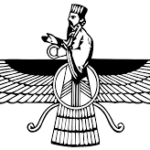
Zoroastrianism symbol
| Symbol | Zoroastrianism |
| Religion | Zoroastrianism Ichthys Symbol - Christianity |
| Origin | The Faravahar symbol is believed to have originated in ancient Persia, possibly during the Achaemenid Empire (550–330 BCE) but gained prominence during the Sassanian Empire (224–651 CE). |
| Meaning | It represents various elements of Zoroastrian cosmology and theology, including the concept of "Fravashi" or guardian spirits, representing the divine guidance and protection of individuals. |
| Appearance | The symbol depicts a winged figure with a human body, often shown in profile, with three main elements: a disc in the center (representing the sun or eternity), two wings (symbolizing good thoughts and good deeds), and a human figure holding a ring (signifying choice between good and evil). |
| Colors | The traditional colors associated with Zoroastrianism include white, symbolizing purity and righteousness, and blue, representing truth and spirituality. These colors are often used in depictions of the Faravahar. |
| Usage | The Faravahar is widely used as a religious and cultural symbol by Zoroastrians, appearing on flags, jewelry, and architectural elements in Zoroastrian communities worldwide. |
| History | The symbol has a long history within Zoroastrianism, evolving over centuries to become a central emblem of the faith, symbolizing its core values and beliefs. |
| Popularity | While Zoroastrianism is a minority religion today, the Faravahar remains a potent symbol of identity and cultural heritage for Zoroastrians worldwide. |
| Importance | The Faravahar symbolizes key concepts of Zoroastrianism, including free will, righteousness, and the eternal battle between good and evil, making it a vital aspect of Zoroastrian religious and cultural identity. |
| Complexity | The Faravahar's symbolism is multifaceted, representing philosophical, theological, and cosmological concepts within Zoroastrianism, reflecting the complexity of the faith itself. |
| Emotions | For adherents of Zoroastrianism, the Faravahar can evoke feelings of spiritual connection, cultural pride, and a sense of belonging to a rich and ancient religious tradition. |
The most recognizable symbol of Zoroastrianism is the Faravahar, also known as the Foruhar or the Farre Kiyâni. While interpretations vary, it generally carries these core meanings:
- Good Thoughts, Words, and Deeds: The central figure represents the ideal human striving for these principles.
- Duality: The two wings and loops symbolize the opposing forces of good (Spenta Mainyu) and evil (Angra Mainyu).The figure faces good, emphasizing choosing the right path.
- Eternity: The circular base represents the never-ending cycle of time and the ever-present nature of these choices.
- Divine Connection: The raised hand could symbolize reaching for Ahura Mazda, the Zoroastrian God.
Beyond these core meanings, the Faravahar can also represent:
- Fravashi: In Zoroastrianism, the spiritual essence of an individual.
- Royal Power: Historically, the symbol appeared on royal objects and continues to hold cultural significance in Iran.